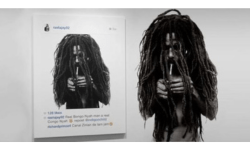Dear Doc:
I heard that “appropriation artist” Richard Prince is again involved in a lawsuit over his theft…uh, “appropriation” of another artist’s photograph. Given the Supreme Court’s decision in the Worhol case about the photograph of Prince, the musician, a few months ago, has anything changed or is Richard Prince still free to swipe anything he feels like?
Signed,
Copyright Nerd
Dear CN:
The Worhol case that the Doc wrote about in June altered how courts are supposed to consider the four factors that make up the fair use defense. The Supreme Court focused attention on the nature and character of the work, and said that if the nature of the use is commercial, then that factor should be the most important (if it’s about money, then fair use is narrowed greatly).
In the case of Graham v. Prince, photographer Donald Graham owned a photograph entitled “Rastafarian Smoking a Joint” (see below). As he had done in the past, Richard Prince reproduced that photo, virtually unchanged, in 2014 as an enlarged Instagram posting to which he added a few comments such as “rastajay92 Real Bongo Nyah man a real Congo Nyah repost @indigoochild” and “richardprince4 Canal Zinian da lam jam.” Prince then sold his version (which the Court called “rastajay92”) to Larry Gagosian, who operates an art gallery in New York. (Mr. Gagosian, you may remember, was also involved in a prior lawsuit over Prince copying photos of Rastafarians.) Here are the photos side-by-side [Prince’s “Rastajay92″ (left) and Graham’s “Rastafarian Smoking a Joint” (right)]:
Gagosian displayed rastajay92 (along with 36 others Prince copied) at his gallery, and produced marketing materials featuring rastajay92 which he sent out to potential purchasers, some of whom paid large sums for the Prince versions (the photos sold collectively for $1.32 million). Graham, naturally, brought a lawsuit in 2015 for copyright infringement against Richard Prince, and also against Gagosian. He sought damages for both the copying of his photo and its use in promoting the sale of other Prince photos copied from other photographers. Graham has also claimed that he should be entitled to Gagosian’s “unrealized profits” should he now sell his copy of rastajay92. After almost 8 years of litigation, the District Court has now decided the issue of whether Graham may recover damages for the use of his photograph by Gagosian.
Earlier this year, the Court found that Prince’s use of Graham’s photo was not fair use and may be an infringement of Graham’s copyright.
In its most recent decision, the Court analyzed the use of rastajay92 in marketing by Gagosian, and found that there was no demonstrable connection between the use of the photo and the decisions of purchasers of the other Prince photos. (The Doc wonders whether one could ever demonstrate that a picture in a catalog is in any way connected to the sale of other things in the catalog. But then, why specifically select that picture, as opposed to just a stock photograph?) Without what the law calls a “nexus” between the copied photo and the reason people bought others, the Court denied Graham any recovery.
As for the “unrealized profits,” the Court found no basis in the Copyright Statute to award these, but did say that Graham would be entitled to the $21,600 that Gagosian paid to Prince for rastajay92, if there was a finding at trial that rastajay92 infringed Graham’s copyright. (To which the Doc reminds the legal system that “justice delayed is justice denied,” and delaying more than 8 years to try this case is, in the Doc’s opinion, a stain on the justice system.)
We’ll have to wait to see what happens at trial, but it seems clear that after the Supreme Court’s ruling about the Prince photo, Richard Prince is very much still in business, and the Courts are still aiding and abetting his “appropriation” of others’ copyrighted works. The law still seems incapable of dealing with the New York “art world” in any common sense manner.
Have a question about intellectual property? Has someone “appropriated” your IP? Give the lawyers at LW&H a call. They know this stuff.
Until next month,
The “Doc”
— Lawrence A. Husick, Esq.



